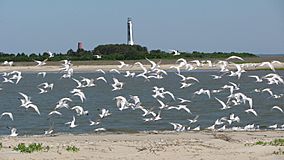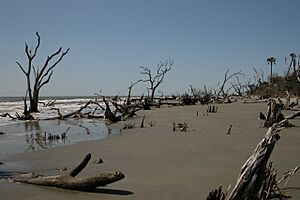Cape Romain National Wildlife Refuge facts for kids
Quick facts for kids Cape Romain National Wildlife Refuge |
|
|---|---|
|
IUCN Category IV (Habitat/Species Management Area)
|
|
 |
|
| Location | Charleston County, South Carolina, United States |
| Nearest city | Awendaw |
| Area | 66,287 acres (26,825 ha) |
| Established | 1932 |
| Visitors | 154,000 (in 2010) |
| Governing body | U.S. Fish and Wildlife Service |
| Website | Cape Romain National Wildlife Refuge |
The Cape Romain National Wildlife Refuge is a huge protected area in southeastern South Carolina. It covers about 66,287 acres (267 square kilometers) near Awendaw, South Carolina. This special place includes lots of water, creeks, bays, and grassy salt marsh areas. It also has several barrier islands.
A big part of the refuge, about 29,000 acres, is a protected wilderness. This means it's kept as wild as possible. Most of the refuge can only be reached by boat. The main office and visitor center are on U.S. Route 17, about 30 minutes from Charleston, South Carolina.
Contents
Saving the Red Wolves: A Comeback Story
In the 1800s, red wolves were common across the southeastern United States. But by the 1960s, their numbers dropped sharply. This happened because of hunting, trapping, and their natural homes being destroyed. Only a few wolves were left in Texas and Louisiana.
To save them, these last wolves were taken into special care. By 1980, there were no red wolves left in the wild. But scientists worked hard to bring them back! In 1987, red wolves were released into safe areas. These included the Alligator River National Wildlife Refuge in North Carolina and Bull Island in South Carolina. They were also released on Horn Island in Mississippi and St. Vincent Island in Florida. This was a big step in helping the red wolf population grow again.
Amazing Animals: Birds and Sea Turtles
The Cape Romain National Wildlife Refuge was created in 1932. Its main goal was to be a safe place for migratory birds. But it also protects other animals that are in danger. These include the loggerhead sea turtle, the wood stork, and the piping plover.
Helping Loggerhead Sea Turtles
Every year, loggerhead sea turtles come to the refuge. They lay their eggs on three of the refuge's barrier islands. This refuge is very important for these turtles. It protects about 23% of the loggerhead sea turtles in the northern part of their range. This is the largest group north of Florida!
For over 30 years, refuge staff have helped these turtles. They find nests that might be washed away by the ocean. Then, they carefully move the eggs to a safer spot on the island. This helps more baby turtles hatch and survive.
Historic Lighthouses of Cape Romain
The Cape Romain National Wildlife Refuge is home to two old lighthouses. They are both on Lighthouse Island. These Cape Romain Lighthouses are very important. They are even listed on the National Register of Historic Places. This means they are recognized as special historical sites.
Exploring Bulls Island
Bulls Island is the biggest of the refuge's barrier islands. It covers about 4,900 acres (20 square kilometers). You can get to Bulls Island by taking a ferry. A private company offers regular boat trips from Garris Landing.
There used to be a third lighthouse on Bulls Island, called Bulls Bay Light. But it stopped working in 1913 and was lost to the sea years ago. Bulls Island also has a unique place called Boneyard Beach. Here, the ocean has slowly taken over a forest. This leaves behind ghostly tree trunks on the sand.
Sewee Visitor & Environmental Education Center
The Sewee Center is a great place to learn about the nature and history of the South Carolina Lowcountry. It has cool displays about different ecosystems and wildlife. You can learn about the ocean life in the Cape Romain National Wildlife Refuge. There are also exhibits about the forest.
The center has a classroom, an auditorium with a film, and an information desk. There's also a book store, a picnic area, and walking trails. The U.S. Fish and Wildlife Service and the U.S. Forest Service work together to run the center. They offer fun nature education programs and activities for everyone.
The South Eastern Wildlife and Environment Education Association (SEWEE Association) is a group that supports the refuge and the Francis Marion National Forest. They help with education and conservation efforts for both places.



